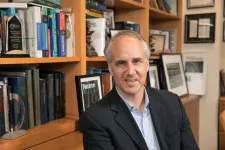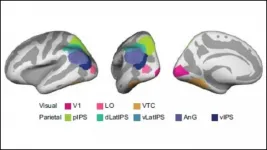INFORMATION:
Brain organoids grown in lab mature much like infant brains
The stem cell-derived organoids follow an internal clock to replicate human brain development
2021-02-22
(Press-News.org) A new study from UCLA and Stanford University researchers finds that three-dimensional human stem cell-derived organoids can mature in a manner that is strikingly similar to human brain development.
For the new study, published in Nature Neuroscience February 22, senior authors Dr. Daniel Geschwind of UCLA and Dr. Sergiu Pasca of Stanford University conducted extensive genetic analysis of organoids that had been grown for up to 20 months in a lab dish. They found that these 3D organoids follow an internal clock that guides their maturation in sync with the timeline of human development.
"This is novel -- Until now, nobody has grown and characterized these organoids for this amount of time, nor shown they will recapitulate human brain development in a laboratory environment for the most part," said Geschwind, MD, PhD, MacDonald Distinguished Professor in Human Genetics at the David Geffen School of Medicine at UCLA, member of the Eli and Edythe Broad Center of Regenerative Medicine and Stem Cell Research at UCLA, and the senior associate dean and associate vice chancellor and director of the Institute for Precision Health at UCLA.
"This will be an important boost for the field. We've shown that these organoids can mature and replicate many aspects of normal human development -- making them a good model for studying human disease in a dish," he said.
Human brain organoids are created using induced pluripotent stem cells, also known as iPS cells, which are derived from skin or blood cells that have been reprogrammed back to an embryonic stem cell-like state allowing scientists to create any cell type.
These iPS cells are then exposed to a specialized mix of chemicals that influences them to create the cell of a certain region of the brain. With time and the right conditions, the cells self-organize to create 3D structures that faithfully replicate several aspects of human brain development.
Human stem cell-derived organoids have the potential to revolutionize the practice of medicine by giving researchers unprecedented insights into how complex organs - including the brain - develop and respond to disease.
For several years, researchers have been growing human brain organoids to study human neurological and neurodevelopmental disorders, such as epilepsy, autism and schizophrenia.
The utility of these models has been hindered by the widespread belief that the cells that make up these organoids remain stuck in a developmental state analogous to the cells seen in fetal development. The study shows that it may be possible to grow the cells to a maturity that will allow scientists to better study adult-onset diseases, such as schizophrenia or dementia.
"There is huge interest in stem cell models of human disease," Geschwind added. "This work represents an important milestone by showing which aspects of human brain development are modeled with the highest fidelity and which specific genes are behaving well in vitro and when best to model them. Equally important, we provide a framework based on unbiased genomic analyses for assessing how well in vitro models model in vivo development and function."
The authors also provide a tool called GECO that allows researchers to browse their genes of interest for measuring fidelity between in vitro and in vivo brain.
"We show that these 3D brain organoids follow an internal clock, which progresses in a laboratory environment in parallel to what occurs inside a living organism," said first author Aaron Gordon, PhD, a post doc in The Geschwind Lab at the David Geffen School of Medicine at UCLA. "This is a remarkable finding -- we show that they reach post-natal maturity around 280 days in culture, and after that begin to model aspects of the infant brain, including known physiological changes in neurotransmitter signaling."
ELSE PRESS RELEASES FROM THIS DATE:
For breakthroughs in slowing aging, scientists must look beyond biology
2021-02-22
A trio of recent studies highlight the need to incorporate behavioral and social science alongside the study of biological mechanisms in order to slow aging.
The three papers, published in concert in Ageing Research Reviews, emphasized how behavioral and social factors are intrinsic to aging. This means they are causal drivers of biological aging. In fact, the influence of behavioral and social factors on how fast people age are large and meaningful. However, geroscience--the study of how to slow biological aging to extend healthspan and longevity--has traditionally not incorporated ...
Traditional hydrologic models may misidentify snow as rain, new citizen science data shows
2021-02-22
Reno, Nev. (Feb. 22, 2021)- Normally, we think of the freezing point of water as 32°F - but in the world of weather forecasting and hydrologic prediction, that isn't always the case. In the Lake Tahoe region of the Sierra Nevada, the shift from snow to rain during winter storms may actually occur at temperatures closer to 39.5°F, according to new research from the Desert Research Institute (DRI), Lynker Technologies, and citizen scientists from the Tahoe Rain or Snow project
The new paper, which published this month in Frontiers in Earth Science, used data collected by 200 volunteer weather spotters to identify the temperature cutoff between rain and snow in winter storms that occurred during the ...
West Virginia's enduring, intertwined epidemics: Opioids and HIV
2021-02-22
Long before COVID-19 entered the picture, West Virginia had been battling two other major public health crises: opioids and HIV.
Dr. Sally Hodder, a leading infectious disease expert at West Virginia University, believes that despite the threat of COVID-19, the opioid and HIV epidemics should not be ignored. The two have become so intertwined in the Mountain State, that they must be treated together, she said.
"We cannot try to solve the opioid epidemic or our emerging HIV epidemic by combating them separately," said Hodder, who serves as director of the West Virginia Clinical and Translational Science Institute and associate vice president ...
Distorting memories helps the brain remember
2021-02-22
In order to remember similar events, the brain exaggerates the difference between them. This results in divergent brain activity patterns but better memory performance, according to new research published in JNeurosci.
Memory is subjective. Different people recall the same event in unique ways, and people exaggerate the difference between similar events in their own life. Yet this type of bias can be advantageous when it helps the brain distinguish between similar things and prevent confusion.
In a study by Zhao et al., participants memorized different sets of faces paired with colored objects. Some ...
Oncotarget: MEK inhibitors relevant to SARS-CoV-2 infection
2021-02-22
The cover for issue 46 of Oncotarget features Figure 6, "Establishment of a SARS-CoV-2 pseudovirus that expresses SPIKE protein variants on the envelope of a lentiviral core, infection of human airway epithelial cells or lung cancer cells, and demonstration of MEKi attenuation of infectivity on primary human cells," published in "MEK inhibitors reduce cellular expression of ACE2, pERK, pRb while stimulating NK-mediated cytotoxicity and attenuating inflammatory cytokines relevant to SARS-CoV-2 infection" by Zhou, et al. which reported that Natural Killer cells and innate-immune TRAIL ...
A dynamic forest floor
2021-02-22
Walk along the beach after a winter storm and you'll see a shore littered with wracks of giant kelp, some 30 to 40 feet long -- evidence of the storm's impact on coastal kelp forests.
Less apparent to the casual beachgoer is what happens to the submarine forests after the storm's fury dies down. This is precisely the topic of a new study led by Raine Detmer(link is external), a graduate student at UC Santa Barbara. She developed a mathematical model describing the effects of severe storms on kelp forest ecosystems, particularly the seafloor, or benthic, communities. The research, published in Ecology (link is external), reveals an ecosystem whose variability is key to its diversity.
Giant kelp ...
Researchers develop speedier network analysis for a range of computer hardware
2021-02-22
Graphs -- data structures that show the relationship among objects -- are highly versatile. It's easy to imagine a graph depicting a social media network's web of connections. But graphs are also used in programs as diverse as content recommendation (what to watch next on Netflix?) and navigation (what's the quickest route to the beach?). As Ajay Brahmakshatriya summarizes: "graphs are basically everywhere."
Brahmakshatriya has developed software to more efficiently run graph applications on a wider range of computer hardware. The software extends GraphIt, a state-of-the-art graph programming language, to ...
Yale neurologists identify consistent neuroinflammatory response in ICH patients
2021-02-22
Understanding how the immune system responds to acute brain hemorrhage could open doors to identifying treatments for this devastating disease. However, up until now, there has been limited information on inflammation in the brain from human patients, especially during the first days after a hemorrhagic stroke.
This led a team of researchers to partner with a large clinical trial of minimally-invasive surgery to tackle defining the human neuroinflammatory response in living patients.
"Our goal was to find out, for the first time, how certain key cells of the immune system are activated when they enter the brain after a hemorrhage and how this may shift over the first week. This ...
NASA's Swift helps tie neutrino to star-shredding black hole
2021-02-22
For only the second time, astronomers have linked an elusive particle called a high-energy neutrino to an object outside our galaxy. Using ground- and space-based facilities, including NASA's Neil Gehrels Swift Observatory, they traced the neutrino to a black hole tearing apart a star, a rare cataclysmic occurrence called a tidal disruption event.
"Astrophysicists have long theorized that tidal disruptions could produce high-energy neutrinos, but this is the first time we've actually been able to connect them with observational evidence," said Robert Stein, a doctoral student at the German Electron-Synchrotron (DESY) research center in ...
Politics and the brain: Attention perks up when politicians break with party lines
2021-02-22
In a time of extreme political polarization, hearing that a political candidate has taken a stance inconsistent with their party might raise some questions for their constituents.
Why don't they agree with the party's position? Do we know for sure this is where they stand?
New research led by University of Nebraska-Lincoln political psychologist Ingrid Haas has shown the human brain is processing politically incongruent statements differently -- attention is perking up -- and that the candidate's conviction toward the stated position is also playing a role.
In other words, there is a stronger neurological response happening when, for example, a Republican takes a position favorable to new taxes, ...
LAST 30 PRESS RELEASES:
Numbers in our sights affect how we perceive space
SIMJ announces global collaborative book project in commemoration of its 75th anniversary
Air pollution exposure and birth weight
Obstructive sleep apnea risk and mental health conditions among older adults
How talking slows eye movements behind the wheel
The Ceramic Society of Japan’s Oxoate Ceramics Research Association launches new international book project
Heart-brain connection: international study reveals the role of the vagus nerve in keeping the heart young
Researchers identify Rb1 as a predictive biomarker for a new therapeutic strategy in some breast cancers
Survey reveals ethical gaps slowing AI adoption in pediatric surgery
Stimulant ADHD medications work differently than thought
AI overestimates how smart people are, according to HSE economists
HSE researchers create genome-wide map of quadruplexes
Scientists boost cell "powerhouses" to burn more calories
Automatic label checking: The missing step in making reliable medical AI
Low daily alcohol intake linked to 50% heightened mouth cancer risk in India
American Meteorological Society announces Rick Spinrad as 2026 President-Elect
Biomass-based carbon capture spotlighted in newly released global climate webinar recording
Illuminating invisible nano pollutants: advanced bioimaging tracks the full journey of emerging nanoscale contaminants in living systems
How does age affect recovery from spinal cord injury?
Novel AI tool offers prognosis for patients with head and neck cancer
Fathers’ microplastic exposure tied to their children’s metabolic problems
Research validates laboratory model for studying high-grade serous ovarian cancer
SIR 2026 delivers transformative breakthroughs in minimally invasive medicine to improve patient care
Stem Cell Reports most downloaded papers of 2025 highlight the breadth and impact of stem cell research
Oxford-led study estimates NHS spends around 3% of its primary and secondary care budget on the health impacts of heat and cold in England
A researcher’s long quest leads to a smart composite breakthrough
Urban wild bees act as “microbial sensors” of city health.
New study finds where you live affects recovery after a hip fracture
Forecasting the impact of fully automated vehicle adoption on US road traffic injuries
Alcohol-related hospitalizations from 2016 to 2022
[Press-News.org] Brain organoids grown in lab mature much like infant brainsThe stem cell-derived organoids follow an internal clock to replicate human brain development







